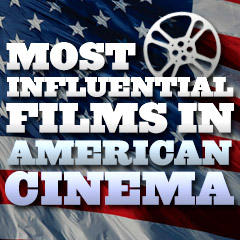Most Influential, Significant
and Important Films in American Cinema
(chronological by time period and film title)
|
|
Title Screen
|
Film Title/Year/Director/Length/Studio,
Descriptions of Influence/Significance |
Poster
|

|
The Public Enemy (1931)
d. William A. Wellman, 83 minutes, Warner Bros./Vitaphone Corp.
- This early sound-era, pre-Code film was Warners'
follow-up to Little
Caesar (1931) released earlier in the same
year. In the next year, Howard Hawks' Scarface
(1932) also attracted
huge audiences with Paul Muni as the notorious criminal Al
Capone. Its
opening was delayed for a few months due to Hawks' and producer Hughes'
continuing squabbles with industry censors over its sensationalism
and glorification of the gangster menace, and issues regarding
the film's retitling.
- It was a box-office smash and one of the earliest
and best of the genre of gangster films. Together, these were
the two quintessential gangster films of the early 1930s. The latter
film was tougher, more violent and realistic (released before
the censorship codes were strictly enforced), although most of the violence
was off-screen.
- With the menacing character of James Cagney in
a dynamic and kinetic performance, most memorably noted as pushing
a grapefruit into the face of moll girlfriend Mae Clarke.
- The film appeared to glamorize criminal activities
such as bootlegging (although that was not its intent), and emphasized
their high style of life with various floozies (portrayed by Joan
Blondell, Mae Clarke, and Jean Harlow). Hence, the film hastened
efforts of Hollywood's self-imposed Production Code in the early
thirties to strictly censor films (with criminal and sexual subject
matter) that depicted undesirable social figures or sexual subjects
in a sympathetic, heroic or realistic way.
|

|
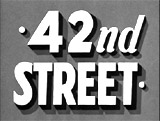
|
42nd Street (1933)
d. Lloyd Bacon, 89 minutes, Warner Bros.
- A classic, fast-paced, backstage movie musical
- a refreshing film about show business that changed the film musical
forever and saved Warner Bros. studios from bankruptcy, helping
it grow into a major studio.
- This film is considered the backstage musical par
excellence, the grand-daddy of them all. It was based on the 'putting-on-a-show'
tradition stemming from MGM's first sound film, The Broadway
Melody (1929), another "backstage musical."
- The first of three landmark
musical films released in 1933 by Warner Bros. to revitalize the
musical film genre (the other two films were Gold Diggers of
1933 (1933) and Footlight
Parade (1933)). Earlier, stage-bound musicals had become box-office
poison after the dawn of the talkies in the late 1920s. Lively
dance numbers (transposed from the stage productions onto film)
were difficult to shoot with large cumbersome cameras, and the
stories were often unexciting.
- Set during the current Depression era, it emphasized
the effects of the current economic downturn on hard-working chorus
girls on stage. It was an unglamorized look at the tough realities
of backstage life behind the footlights. The urban milieu of the
film is filled with crisp, slangy, bitter dialogue and wisecracks,
street-wise characters, topical references, desperately-striving
chorines, dancers, and crew, and down-and-out references to the
Depression.
- The first major work of Busby Berkeley, a tremendously
talented choreographer, whose direction of voyeuristic, surrealistic
production numbers was illustrated in extravagant, musical numbers,
giant kaleidoscopes of imagery, dancing girls forming geometrically-shaped,
abstract designs and patterns, and innovative camera images. He
was particularly known for his overhead shots, freely-moving camera
(dollies and pans), and for creating numbers especially-made for
films that went far beyond conventional boundaries. He became widely
imitated.
|

|

|
I'm No Angel (1933)
d. Wesley Ruggles, 87 minutes, Paramount Pictures
- The sultry, busty blonde bombshell and sexy star/comedienne
Mae West, brought westward from Broadway by Paramount, appeared
in two films in the same year: I'm
No Angel (1933) and She
Done Him Wrong (1933). In both films, her co-star was supporting
actor Cary Grant.
- The controversial films were filled with wisecracks,
one-liners, and racy double entendres within her promiscuous dialogue,
suggestive songs and bawdy body language. All of this raised
the ire of the Production Code.
- Her performances, displaying a classic combination
of sex, verbal lust, comedy, and suggestiveness, spurred the movement
for greater movie censorship by the mid-1930s through the Hays
Office. Only one year after West's films,
the Hays Production Code released a list of "do's
and don'ts" for film-making - as a way to censor Hollywood
films.
- The way that sex was portrayed on the screen would
be changed
for many decades. It would be over 30 years
before changes in the depiction of sex on screen would appear,
with a new, more permissive advisory rating system. (Soon after
the loosening of censorship, the X-rated Best Picture-winning Midnight
Cowboy (1969) would
be released.)
|

|
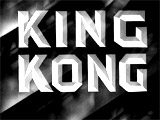
|
King Kong (1933)
d. Merian C. Cooper and Ernest B. Schoedsack (uncredited),
100/104 minutes, RKO Radio Pictures
- Perhaps cinema's most original creation - RKO's
spectacular, campy adventure/fantasy film - a metaphoric re-telling
of the archetypal Beauty and the Beast fable.
- When released, it broke all previous box-office
records. Its massive, money-making success helped to save RKO Pictures
from bankruptcy.
- A phenomenal, influential landmark film that raised
the bar for special effects for many decades - due to the genius
of chief technical-special effects man Willis H. O'Brien, famed
for his first feature film The Lost World (1925). It utilized
sequences with stop-motion animation, miniature models about 18
inches high, trick photography, and one of the earliest uses of
back- (or rear) projection. It was extremely influential on up-and-coming
special effects artist Ray Harryhausen.
- It was the first film to be heavily promoted on
the radio.
- It was accompanied by Max Steiner's dramatic and
emphatic score. It was noted as the first feature-length musical
score written specifically for a US 'talkie' film, and was the
first major Hollywood film to have a thematic score rather than
background music, recorded using a 46-piece orchestra. For
the first time in film history, RKO's sound department head Murray
Spivak made a groundbreaking sound design decision - he pitched
the effects to match the score, so they wouldn't be overwhelming
and so they would complement each other.
- An iconic monster movie about a giant ape, King
Kong launched the "giant beast" or "giant monster" (known
as kaiju in Japan) subgenre of science-fiction, inspiring
the 1950's atomic mutant creature features and the Japanese giant
movie monsters like Godzilla, Gamera, Rodan, etc. - numerous remakes,
and even Cloverfield
(2008) years later.
|

|
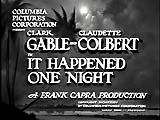
|
It Happened One Night (1934)
d. Frank Capra, 105 minutes, Columbia Pictures
- One of the greatest romantic
comedies in film history, and a film that has endured in popularity.
It is considered one of the pioneering "screwball" romantic
comedies (noted for rapid fire dialogue) of its time, setting the
pattern for many years afterwards, along with other contemporary
films, such as The
Thin Man (1934) (with screen couple Myrna Loy and William
Powell), and Twentieth Century (1934) (with Carole Lombard
and John Barrymore).
- The story, actually a road trip, presented the unlikely
romantic pairing of a mis-matched couple (the theme of opposites
attract) - a reversal of the Cinderella story (the heroine had
rejected her wealthy lifestyle).
- The modern tale - an escapist theme - was a big
hit with Depression-weary audiences. It was filled with light-hearted
sex appeal in which courtship and love triumphed over class conflicts,
socio-economic differences, and verbal battles of wit.
- It was an unexpected runaway
box office sleeper hit (especially after it began to play in small-town
theaters), and it garnered the top five (or "Big Five") Academy
Awards for the first time in Oscar history. It was unrivaled until
1975, forty-one years later by One
Flew Over the Cuckoo's Nest (1975) - and then again by The
Silence of the Lambs (1991).
- Marketing lessons could be learned from the film.
With his good-natured, street-smart, and breezy performance, Clark
Gable influenced the un-sale of undershirts by taking off his shirt
and exposing his bare chest, and bus travel by women substantially
increased as a result of the film.
- Animation expert Friz Freleng, in his unpublished
memoirs, claimed that the film helped to inspire the creation of
various cartoon characters: Bugs Bunny, Pepe LePew, and Yosemite Sam.
- Romantic comedy road films, such as The Sure
Thing (1985) and When
Harry Met Sally... (1989) owed their success
to this film.
|
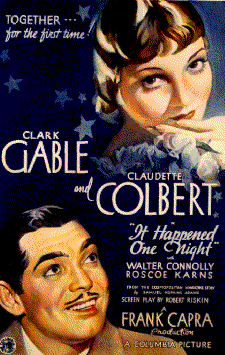
|

|
Becky Sharp (1935)
d. Rouben Mamoulian, 84/67 minutes, Pioneer Pictures Corp./RKO
- This was the first feature-length Technicolor film
to be shot entirely in 3-strip color (although the color did not
look completely realistic). There was now a separate film register
for each of the three primary colors. The new 3-strip process was
created by adding a blue film record to the red and green components
of Technicolor's earlier two-color process.
- This striking development that forever changed cinema
encouraged the making of color motion picture films in Britain
and the US in the years before World War II.
- It was a milestone film dramatizing
William Makepeace Thackeray's novel Vanity Fair with Miriam
Hopkins in the title role.
|

|

|
Snow White and the Seven Dwarfs (1937)
d. William Cottrell, David Hand, 83 minutes, Walt Disney Productions
- The first full-length animated feature (83 minutes
in length) in color and with sound, one of Disney's greatest films,
and a pioneering classic tale in film history. It
was the first commercially successful film of its kind and a technically
brilliant, innovative example of Disney animation.
- Disney realized that he had to expand and alter
the format of cartoons. However, his innovative
project was often dubbed "Disney's
Folly" during
the three to four year production of the musical animation. It
took almost four years and an astronomical (at the time) $1.7 million
to create. It was feared that it would be a big flop - until its
release.
- The risk-taking film made use of the multi-plane
camera (first used in Disney's own animated, Oscar-winning Silly
Symphonies short, The Old Mill (1937)) to create an
illusion of depth.
- It introduced human characters (the jealous
Queen, the Huntsman, the Prince, and Snow White herself) modeled
on live actors, and used larger painted cels and drawing boards.
- It was the first film with an official soundtrack
and the first film to release a motion picture soundtrack album.
- For the film's remarkable achievement, Walt Disney
was awarded with an Honorary Oscar - the film was
"recognized as a significant screen innovation which has charmed millions
and pioneered a great new entertainment field for the motion picture cartoon."
|

|

|
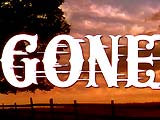
|
Gone With the Wind (1939)
d. Victor Fleming, 238 minutes, Selznick Int'l Pictures/MGM
- The most beloved, enduring and popular film of
all time - cinema's
greatest, star-studded, historical epic film of the Old South during wartime
that boasted an immortal cast in a timeless, classic tale of a
love-hate romance.
- This big-screen, blockbuster adaptation of Margaret
Mitchell's 1936 best-selling novel was a 228-minute Civil War epic
drama that went on to profitably gross almost $200 million (domestic)
(and $400 million worldwide) - highest-grossing film status at
the time.
- The touchstone film had a production cost of
over $4 million - it was the longest and most expensive Hollywood
sound film of the time.
- Adjusted for inflation, this remains the highest
grossing film ever made (at $1.676 billion), and one of the original
blockbusters on the silver screen.
- Noted for its three years of advanced publicity
and tremendous Hollywood myth-making. Producer
David O. Selznick's expensive Civil War era epic set a major
pattern or blueprint for future grand epics.
- The film (originally rough-cut at 6 hours in length)
was challenging in its making, due to its controversial subject
matter (including rape, drunkenness, moral dissipation and adultery
- and its depiction of slavery) and its epic qualities, with more
than 50 speaking roles and 2,400 extras.
- It won eight competitive statues (including Best
Picture) - a record for its time that lasted for 20 years (until Ben-Hur
(1959) won 11 Oscars).
- It was the first color film to win Best Picture.
- Best Supporting
Actress Hattie McDaniel became the first African-American performer
to win an Oscar (she was also the first African-American nominee
for an Oscar, and the first African-American guest at the awards
ceremony).
- Its casting call for the lead female role of Scarlett
O'Hara ended up being one of the biggest ever with over 30 well-known
actresses being considered for the highly desired role. In all,
1,400 actresses were interviewed for the part,
and 400 performed audition-readings. Little-known
British actress Vivien Leigh was signed on for the role. Casting
calls such as this one inspired future, fiery leading ladies, such
as Kate Winslet in Titanic
(1997).
- It continues to inspire critical attention and debate,
the purchase of memorabilia, references to its many quotable lines,
and numerous re-releases over the years.
|

|
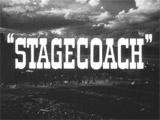
|
Stagecoach (1939)
d. John Ford, Walter Wanger Productions/United Artists
- A classic Western from film auteur John Ford. This
film - his first sound Western - was a return to his most-acclaimed
film genre after a thirteen year absence. By 1939, the Western
genre had fallen out of favor, but Stagecoach helped to reinvent
the genre, providing for its rebirth.
- This classic frontier western was the first film
that director Ford shot in Utah's iconic Monument Valley -- the site
would repeatedly be used as the locale for most of his other Westerns.
It marked the first of seven films he made in the
famed western valley.
- The film marked the breakthrough, star-making role
for B-western actor John Wayne, as Ringo Kid.
- This revolutionary, influential film - a story of
redemption - is considered a landmark quintessential film that
elevated westerns from cheaply-made, low-grade, Saturday matinee "B" films
to a serious adult genre - one with greater sophistication, richer
Western archetypes and themes, in-depth and complex characterizations,
and greater profitability and popularity as well.
- It combined
typical genre elements plus a rich character study of its characters.
Major social issues and themes (sexual and social prejudice, alcoholism,
childbirth, greed, shame, redemption and revenge) were closely
mixed together into an exciting adventure story.
|

|
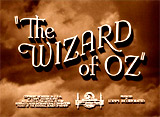
|
The Wizard of Oz (1939)
d. Victor Fleming, 102 minutes, MGM
- Everybody's cherished favorite, a perennial fantasy
film musical from MGM during its golden years, and one of the best
known films of all-time.
- Set a precedent for TV showings and viewings: for
many seasons, it was featured regularly on network TV as a prime
time event (its first two showings were on CBS television on November
3, 1956 and in December, 1959).
It soon became a classic institution with annual showings for Thanksgiving,
Christmas, and/or Easter time, and was a rite of passage for everyone, and
probably has been seen by more people than any other motion picture over
multiple decades. According to the Library of Congress, the musical fantasy
is the most watched movie in history.
- Its legacy remains strong: the classic film has
been honored with dozens of books, TV shows (such as HBO's dramatic
prison series Oz), references in other films or remakes,
Broadway shows, and even by pop groups (singer Elton John with
his Goodbye,
Yellow Brick Road album, or Pink Floyd's 1973 album Dark
Side of the Moon).
- The film perfectly integrated the musical numbers
(songs by Harold Arlen and E.Y. ('Yip') Harburg) with the action
of the plot - enhancing and advancing the suspenseful narrative.
- The scenes in bleak Kansas were shot in drab sepia
tone, with brilliant, vibrant, 3-strip Technicolor used for the
fantasy scenes in the journey to Oz. The special effects, by Arnold
Gillespie, included the cyclone sequence, the flying winged monkeys,
the Emerald City views, the poppyfield, and the message written
by the witch in the sky: "Surrender Dorothy."
- For its time, it was noted for its most elaborate
use of character make-ups and special effects.
- Of its two Oscar wins for its musical components,
one was the well-known Best Original Song: "Over the Rainbow" -
and the film has one of the most quotable scripts, with dozens
of quotes indelibly remembered and referenced in popular culture
(including
"Lions and tigers and bears, oh my!", "I'm melting! I'm melting!", "We're
not in Kansas anymore," "I'll get you, my pretty. And your little
dog too", "Follow the Yellow Brick Road," or
the film's final line: "There's no place like home").
- Probably the most revered and valuable film memorabilia
item in movie history is Dorothy's ruby slippers, displayed in
the Smithsonian Museum.
|

|
